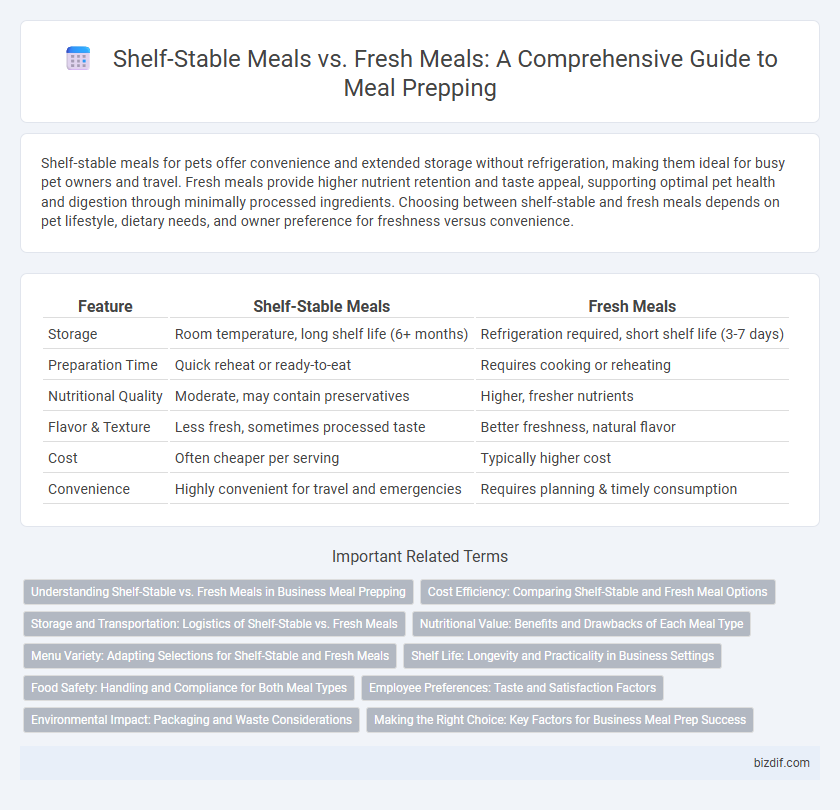Shelf-stable meals for pets offer convenience and extended storage without refrigeration, making them ideal for busy pet owners and travel. Fresh meals provide higher nutrient retention and taste appeal, supporting optimal pet health and digestion through minimally processed ingredients. Choosing between shelf-stable and fresh meals depends on pet lifestyle, dietary needs, and owner preference for freshness versus convenience.
Table of Comparison
| Feature | Shelf-Stable Meals | Fresh Meals |
|---|---|---|
| Storage | Room temperature, long shelf life (6+ months) | Refrigeration required, short shelf life (3-7 days) |
| Preparation Time | Quick reheat or ready-to-eat | Requires cooking or reheating |
| Nutritional Quality | Moderate, may contain preservatives | Higher, fresher nutrients |
| Flavor & Texture | Less fresh, sometimes processed taste | Better freshness, natural flavor |
| Cost | Often cheaper per serving | Typically higher cost |
| Convenience | Highly convenient for travel and emergencies | Requires planning & timely consumption |
Understanding Shelf-Stable vs. Fresh Meals in Business Meal Prepping
Shelf-stable meals in business meal prepping offer extended preservation without refrigeration, relying on methods like vacuum sealing and dehydration to maintain safety and nutritional value. Fresh meals provide higher taste quality and nutrient retention but require faster turnover and reliable cold chain logistics to prevent spoilage. Balancing shelf-stability and freshness involves analyzing customer preferences, storage capabilities, and delivery timelines to optimize operational efficiency and reduce food waste.
Cost Efficiency: Comparing Shelf-Stable and Fresh Meal Options
Shelf-stable meals often provide greater cost efficiency due to longer shelf life and bulk packaging, reducing food waste and frequent grocery trips. Fresh meals, while offering superior taste and nutrient retention, typically incur higher costs from spoilage and daily purchasing needs. Budget-conscious consumers benefit from balancing shelf-stable options for convenience and fresh meals for variety and quality.
Storage and Transportation: Logistics of Shelf-Stable vs. Fresh Meals
Shelf-stable meals offer significant advantages in storage and transportation due to their long shelf life and minimal refrigeration requirements, reducing costs and complexity in logistics. Fresh meals require refrigerated or frozen transport and storage, increasing the need for temperature-controlled environments to maintain food safety and quality. Efficient supply chain management is crucial for fresh meals to prevent spoilage, while shelf-stable options allow for more flexible distribution and extended storage periods.
Nutritional Value: Benefits and Drawbacks of Each Meal Type
Shelf-stable meals offer convenience and longer storage times but often contain higher levels of preservatives, sodium, and reduced nutrient retention compared to fresh meals. Fresh meals typically provide superior nutritional value with higher concentrations of vitamins, minerals, and antioxidants essential for optimal health. Balancing both meal types can help optimize diet quality and lifestyle flexibility.
Menu Variety: Adapting Selections for Shelf-Stable and Fresh Meals
Shelf-stable meals typically offer a more limited menu variety due to preservation constraints, favoring items like canned soups, dried pasta, and vacuum-sealed proteins that maintain quality over time. Fresh meals provide greater flexibility in incorporating seasonal ingredients, diverse textures, and vibrant flavors, allowing for creative and varied menu options. Tailoring selections to balance shelf-stability with nutritional value and taste ensures a well-rounded meal prep strategy catering to different lifestyle needs.
Shelf Life: Longevity and Practicality in Business Settings
Shelf-stable meals offer extended shelf life ranging from several months to years without refrigeration, making them ideal for bulk storage and reducing food waste in commercial kitchens. Fresh meals, while preferred for taste and nutritional value, typically spoil within days, requiring frequent replenishment and higher operational costs. The longevity and practicality of shelf-stable meals enhance supply chain efficiency and ensure consistent product availability in business settings.
Food Safety: Handling and Compliance for Both Meal Types
Shelf-stable meals require strict adherence to food safety protocols such as proper sealing, dehydration, and temperature control to prevent bacterial growth and ensure compliance with regulatory standards. Fresh meals demand vigilant handling practices including refrigeration, cross-contamination avoidance, and timely consumption to maintain safety and nutrient integrity. Both meal types must follow Hazard Analysis Critical Control Point (HACCP) guidelines for monitoring potential hazards and maintaining compliance with food safety laws.
Employee Preferences: Taste and Satisfaction Factors
Employee preferences between shelf-stable meals and fresh meals hinge largely on taste quality and overall satisfaction. Fresh meals are typically favored for their superior flavor, texture, and perceived health benefits, contributing to higher employee morale and productivity. Shelf-stable meals offer convenience and longer storage life but often fall short in delivering the same sensory satisfaction that influences employee meal choices.
Environmental Impact: Packaging and Waste Considerations
Shelf-stable meals typically use airtight, often single-use packaging that extends shelf life but contributes to increased plastic and aluminum waste, impacting landfill accumulation and recycling challenges. Fresh meals generally require less intensive packaging, reducing plastic use and lowering overall environmental footprint, though they present higher food waste risks due to shorter shelf life. Opting for reusable containers and minimizing excess packaging can help mitigate the environmental impact in both meal prepping methods.
Making the Right Choice: Key Factors for Business Meal Prep Success
Shelf-stable meals offer extended shelf life and reduced waste, making them ideal for businesses prioritizing inventory management and cost-efficiency. Fresh meals appeal to health-conscious consumers demanding high nutritional value and vibrant flavors, enhancing brand reputation and customer satisfaction. Successful meal prep businesses balance these factors by analyzing target market preferences, storage capabilities, and delivery logistics to optimize product offerings.
Shelf-stable meals vs Fresh meals Infographic

 bizdif.com
bizdif.com